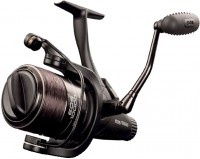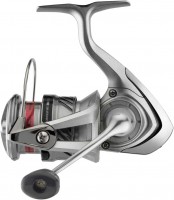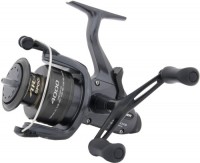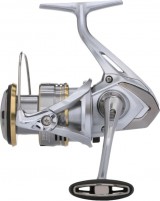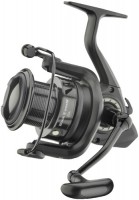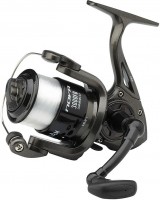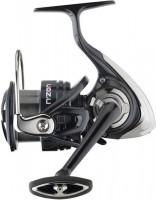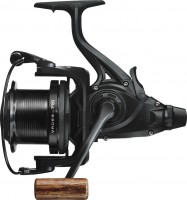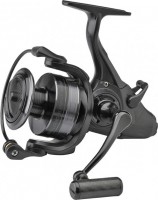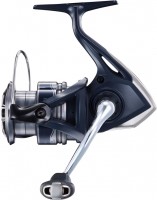Reels Ryobi
All Reels Advanced filters → |
You might be interested in
Reels: specifications, types
Type
— Fly fishing. The simplest type of reel in design, in fact, it is a drum (spool) for fishing line with a brake device and a handle for rotation attached to one side. Due to this design, the gear ratio (see below) of such coils is, by definition, equal to one, and the axis of rotation of the drum coincides with the axis of rotation of the handle. When casting with unwinding of the fishing line, the spool rotates, providing braking gear due to its own inertia (because of this, this type of reel is also called inertial, but this is not entirely true — inertial varieties are distinguished into a separate type, see below). The main advantage of fly fishing models is the simplicity of design, which in fact provides several points at once. Firstly, due to the lack of transmission mechanisms, the fisherman more accurately “feels the tackle”; secondly, for the same reason, the coils are very easy to maintain, reliable and at the same time inexpensive; thirdly, the low gear ratio (see below) provides good effort when winding the line. On the other hand, due to the braking action of the drum, the casting distance with such reels is lower than with inertialess ones, and if the spin is too strong, a “beard” may occur. Accordingly, for a successful cast, a large open space and a certain amount of experience are required.
— Inertialess. Coils of a characteristic type, with a sp...ool, the axis of which is directed perpendicular to the axis of rotation of the handle (parallel to the rod). The name is due to the fact that when casting with unwinding line, the drum does not rotate — thus, the inertia of the system is minimal and the line comes off almost freely. This ensures a long casting distance and minimal chance of tangling into a “beard”, which makes these reels very easy to use and suitable even for beginners. In addition, inertialess models can have different gear ratios and the corresponding specialization — for speed or for pulling force; and the presence of a friction brake reduces the risk of line breakage during sharp jerks of prey. At the same time, the cost of such reels is significantly higher than that of fly fishing reels, the abundance of mechanisms somewhat reduces reliability, and rather high gear ratios affect traction (although specialized “power” reels usually cope with their task without problems).
— Multiplier. This type of coil combines the features of both options described above. In such models, as in fly fishing, the axis of rotation of the spool is directed in the same direction as the axis of rotation of the handle, however, the spool itself is connected to the handle not directly, but through a mechanism with relatively low gear ratios (usually at the level of "power" inertialess coils ). When casting with unwinding line, the drum of such a reel rotates, but its inertia is not as great as that of fly fishing models, which provides a greater casting distance and less chance of tangling. And the presence of a transmission mechanism made it possible to provide some special functions in the design, such as a friction brake, a line layer, etc.; at the same time, multiplier models outperform inertialess ones in terms of reliability, sensitivity and tractive effort. It is these reels that are often used for sea fishing, where you have to deal with large prey.
— Inertial. According to the general design principle, such reels are similar to fly fishing reels (see above): in particular, they do not use additional mechanisms for transmitting rotation, the handle is installed directly on the spool. The key difference is that inertial models are noticeably more powerful and heavier, which allows them to be used for heavy loads and work with thick fishing lines, and in some cases steel wires. In addition, most of these models are designed for bottom fishing.
— Spincast. Spincast reels have a closed design with a protective casing or cover, under which all the main components (spool and mechanism) are hidden. According to the principle of operation, such coils are closest to inertia-free ones (see the corresponding paragraph). The closed design prevents dirt, water and debris from getting inside, making the reel less prone to breakage when used in harsh conditions. Their simplicity makes spincast reels an excellent choice for beginner anglers and those on a budget. They are usually used for catching small and medium-sized fish.
— Inertialess. Coils of a characteristic type, with a sp...ool, the axis of which is directed perpendicular to the axis of rotation of the handle (parallel to the rod). The name is due to the fact that when casting with unwinding line, the drum does not rotate — thus, the inertia of the system is minimal and the line comes off almost freely. This ensures a long casting distance and minimal chance of tangling into a “beard”, which makes these reels very easy to use and suitable even for beginners. In addition, inertialess models can have different gear ratios and the corresponding specialization — for speed or for pulling force; and the presence of a friction brake reduces the risk of line breakage during sharp jerks of prey. At the same time, the cost of such reels is significantly higher than that of fly fishing reels, the abundance of mechanisms somewhat reduces reliability, and rather high gear ratios affect traction (although specialized “power” reels usually cope with their task without problems).
— Multiplier. This type of coil combines the features of both options described above. In such models, as in fly fishing, the axis of rotation of the spool is directed in the same direction as the axis of rotation of the handle, however, the spool itself is connected to the handle not directly, but through a mechanism with relatively low gear ratios (usually at the level of "power" inertialess coils ). When casting with unwinding line, the drum of such a reel rotates, but its inertia is not as great as that of fly fishing models, which provides a greater casting distance and less chance of tangling. And the presence of a transmission mechanism made it possible to provide some special functions in the design, such as a friction brake, a line layer, etc.; at the same time, multiplier models outperform inertialess ones in terms of reliability, sensitivity and tractive effort. It is these reels that are often used for sea fishing, where you have to deal with large prey.
— Inertial. According to the general design principle, such reels are similar to fly fishing reels (see above): in particular, they do not use additional mechanisms for transmitting rotation, the handle is installed directly on the spool. The key difference is that inertial models are noticeably more powerful and heavier, which allows them to be used for heavy loads and work with thick fishing lines, and in some cases steel wires. In addition, most of these models are designed for bottom fishing.
— Spincast. Spincast reels have a closed design with a protective casing or cover, under which all the main components (spool and mechanism) are hidden. According to the principle of operation, such coils are closest to inertia-free ones (see the corresponding paragraph). The closed design prevents dirt, water and debris from getting inside, making the reel less prone to breakage when used in harsh conditions. Their simplicity makes spincast reels an excellent choice for beginner anglers and those on a budget. They are usually used for catching small and medium-sized fish.
Handle placement
The standard location of the reel handle. This parameter is relevant mainly for fly fishing and multiplier models, because inertialess (see "Type") usually provide the possibility of reinstalling the handle.
The choice for this parameter depends primarily on which hand is more convenient for you to hold the rod. If you hold it in your right hand, then the coil should be left-sided, since the left hand remains free to work with it, and vice versa.
The choice for this parameter depends primarily on which hand is more convenient for you to hold the rod. If you hold it in your right hand, then the coil should be left-sided, since the left hand remains free to work with it, and vice versa.
Number of bearings
The number of bearings provided in the design of the reel. Bearings are used to reduce friction of rotating parts, which, on the one hand, protects such parts from wear, and on the other hand, reduces excessive effort expended when the handle is rotated. Accordingly, the more bearings, the more friction units are protected and the better the coil is “optimized”; this parameter is a good indicator of the overall class of the product. At the same time, it is necessary to evaluate different models taking into account their purpose (see "Type").
So, in fly fishing reels, even quite expensive ones, 1 bearing is usually provided — at the point of installation of the drum on a bracket designed for attachment to the rod. This is actually the only significant friction point, so more bearings are simply not required. For multiplier reels, this number varies from 1 for relatively simple options to 6 – 7 for premium ones. And in inertia-free bearings, the number of bearings can reach a couple of dozen.
So, in fly fishing reels, even quite expensive ones, 1 bearing is usually provided — at the point of installation of the drum on a bracket designed for attachment to the rod. This is actually the only significant friction point, so more bearings are simply not required. For multiplier reels, this number varies from 1 for relatively simple options to 6 – 7 for premium ones. And in inertia-free bearings, the number of bearings can reach a couple of dozen.
Drag
The clutch type describes the location of the friction brake mechanism provided in the reel and, accordingly, its adjustment knob.
The friction brake itself is responsible for loosening the reel at a critical force: when the load increases significantly, a properly adjusted friction clutch pits part of the fishing line, preventing it from breaking. But the specific actuation force may differ: some fishermen prefer to loosen the brake as much as possible, allowing the line to slip with rather weak jerks, while others, on the contrary, tighten it, allowing operation only when dangerously approaching the breaking load. And in some situations, you need to change the settings right in the process of playing. The convenience of such a reconfiguration is one of the points that is affected by the type of clutch. In addition, design features may be due to the purpose of the coil. Specific options might be:
— Front. Friction located directly in the drum, with an adjustment knob on the front of the reel. It is used in inertialess models (see "Type"). It is slightly lighter and simpler in design than the rear one, making it well suited for light tackle (for example, when fishing in a match). But the adjustment of such a brake, on the one hand, is smoother and more accurate than that of the rear one, on the other hand, it is not so convenient when setting it up on the fly and requires a certain skill....In addition, the front clutch is more sensitive to dirt.
— Rear. Another option for placing the clutch in inertialess models. Its name is due to the fact that the drag is located behind the spool, and the adjustment knob is on the back of the reel. Such coils allow you to easily reconfigure the brake right during the fight, and their balance is somewhat more convenient than that of the “front-wheel drive”, because. the design does not have a characteristic "overweight" forward. On the other hand, the adjustment in this case is less accurate, and the coils themselves are somewhat larger and heavier, which makes them poorly suitable for ultralight gear.
— Side. A similar placement of the clutch is typical for multiplier coils — it makes no sense to use other options in such models, as well as to put a side clutch in an inertialess model.
The friction brake itself is responsible for loosening the reel at a critical force: when the load increases significantly, a properly adjusted friction clutch pits part of the fishing line, preventing it from breaking. But the specific actuation force may differ: some fishermen prefer to loosen the brake as much as possible, allowing the line to slip with rather weak jerks, while others, on the contrary, tighten it, allowing operation only when dangerously approaching the breaking load. And in some situations, you need to change the settings right in the process of playing. The convenience of such a reconfiguration is one of the points that is affected by the type of clutch. In addition, design features may be due to the purpose of the coil. Specific options might be:
— Front. Friction located directly in the drum, with an adjustment knob on the front of the reel. It is used in inertialess models (see "Type"). It is slightly lighter and simpler in design than the rear one, making it well suited for light tackle (for example, when fishing in a match). But the adjustment of such a brake, on the one hand, is smoother and more accurate than that of the rear one, on the other hand, it is not so convenient when setting it up on the fly and requires a certain skill....In addition, the front clutch is more sensitive to dirt.
— Rear. Another option for placing the clutch in inertialess models. Its name is due to the fact that the drag is located behind the spool, and the adjustment knob is on the back of the reel. Such coils allow you to easily reconfigure the brake right during the fight, and their balance is somewhat more convenient than that of the “front-wheel drive”, because. the design does not have a characteristic "overweight" forward. On the other hand, the adjustment in this case is less accurate, and the coils themselves are somewhat larger and heavier, which makes them poorly suitable for ultralight gear.
— Side. A similar placement of the clutch is typical for multiplier coils — it makes no sense to use other options in such models, as well as to put a side clutch in an inertialess model.
Gear ratio
The gear ratio describes the difference in the speed of rotation of the spool and the handle. In reel specifications, it is often written as a ratio of the form x:1, where one indicates 1 turn of the handle, and “x” is the number of turns of the spool in one such turn. To simplify the record, only the first number is indicated in our catalog — for example, the designation 5.2 corresponds to a gear ratio of 5.2: 1.
First of all, the ratio between the speed and the "torque" of the coil depends on this parameter. So, high gear ratios allow you to quickly pull the line, which is important for high-speed wiring — but the power of such reels will be low, and significant efforts on the handle will be required to pull large prey. Conversely, at low numbers, the speed of the line will be small, but you will not have to make significant efforts to move it. In models of the inertialess type (see above), gear ratios of the order of 6 – 7 denote the so-called "high-speed" coils, 4 – 4.5 – "power", and intermediate values \u200b\u200bare universal. Due to their specificity, multiplier models usually have low gear ratios, and the high power of fly fishing reels is due to the fact that the angler rotates the drum directly in them, and the gear ratio is 1.
First of all, the ratio between the speed and the "torque" of the coil depends on this parameter. So, high gear ratios allow you to quickly pull the line, which is important for high-speed wiring — but the power of such reels will be low, and significant efforts on the handle will be required to pull large prey. Conversely, at low numbers, the speed of the line will be small, but you will not have to make significant efforts to move it. In models of the inertialess type (see above), gear ratios of the order of 6 – 7 denote the so-called "high-speed" coils, 4 – 4.5 – "power", and intermediate values \u200b\u200bare universal. Due to their specificity, multiplier models usually have low gear ratios, and the high power of fly fishing reels is due to the fact that the angler rotates the drum directly in them, and the gear ratio is 1.
Baitrunner
The presence of a baitrunner in the design of the coil. A baitrunner is a special device for bleed fishing line, used when catching large strong fish, primarily carp. The bite of such prey, even with relatively small sizes, can be so powerful and sharp that with the main clutch clamped, the fish can break the line or even break the rod. At the same time, without the brake being pressed, it is impossible to perform effective hooking. Bayrunner resolves this contradiction. When turned on, it allows the line to come off the reel with some effort, ignoring the main drag — this reduces the risk of breaks and other troubles during strong jerks, while maintaining control over the tackle. And when the baitrunner is turned off, the reel starts to work as usual, which ensures the convenience of playing. Switching between these modes is carried out with one movement of a special lever located on the back of the reel — this is much faster and more convenient than reconfiguring the clutch.
Coils with this feature are subject to special requirements for strength and reliability, so their cost is usually quite high.
Coils with this feature are subject to special requirements for strength and reliability, so their cost is usually quite high.
Spool size
The size of the main spool (drum) of the reel. This parameter directly affects the weight of the coil and its resistance to stress. It uses a symbol in thousands; in order not to go into unnecessary details, we can say that the larger the number in such a designation, the larger and heavier the drum. For different purposes, different sizes will be optimal. So, spools for 2500 – 3000 are considered universal, they can be used for both float fishing and spinning fishing in simple conditions. The smaller size is recommended for light tackle, including ultralight category, and equipment for large and heavy prey (for example, when fishing for carp) may include reels for 4500 – 5000 and even more.
Class
To classify fly fishing rods according to the weight of the lures, division into classes according to AFTMA (Fishing Products Manufacturers Association) is used. There are 21 classes in total: 000, 00, 0 and further up to 18. The higher the number, the heavier the bait can be used, however, as the class increases, the rod itself gains weight. A novice fisherman should choose classes 5–7, which will provide comfortable fishing with small flies and medium-sized streamers. And, for example, it is recommended to go sea fishing for powerful trophies with models of class 10 and above.
Spool capacity
The amount of line that can fit on the main spool of a reel with normal winding. It is indicated as a ratio of two numbers, the first of which corresponds to the length of the reeled line in metres, and the second to the thickness in millimetres: for example, the numbers 200 / 0.45 indicate that up to 200 m of fishing line with a thickness of 0.45 mm can fit on the reel.
For different types of fishing, there are recommendations on the optimal value of this parameter; they can be found in special sources. Here we note that the capacity of the spool is indicated exclusively for a smooth fishing line; when using a braided cord, the actual performance may differ markedly.
For different types of fishing, there are recommendations on the optimal value of this parameter; they can be found in special sources. Here we note that the capacity of the spool is indicated exclusively for a smooth fishing line; when using a braided cord, the actual performance may differ markedly.
Winding the line per turn
This parameter determines how much line is wound/unwound in one full turn of the handle. The greater the value of the line winding per revolution, the less force must be applied when pulling the catch, at the same time, the winding speed also increases. An average ordinary reel winds around 50 cm of fishing line in one turn of the handle.
Pulling force
Pulling force determines the maximum weight that the reel can regularly pull on itself, without negative consequences in the future. So, the pulling force of the average coil is at the level of 2-3 kg. Such a model can be entrusted with pulling ashore, with the help of one reel, most of the freshwater fish, from crucian and carp to bream, perch and carp. If you plan to catch catfish, pike or sea fish, then it is better to use a reel with high traction.
Also note that experienced fishermen usually pull the catch ashore not at the expense of the reel, but with the rod itself, using the “fighting” technique. Working with a rod allows you to almost significantly unload the reel.
Worm shaft
A worm shaft, a “worm”, an endless screw — all this indicates the presence of a movable up and down spool, which contributes to uniform winding of the fishing line. As a result, tangling of the fishing line and the formation of a "beard" is almost impossible. At the same time, the worm shaft prevents the line from winding like a “carrot” when there is more line in one area than in another. Accordingly, there will be no problems with the fishing line and casting will be equally comfortable every time.
Instant anti-reverse
Instant stop of the reverse motion of the coil when unwinding. It is very important in jig fishing with stepped wiring, when you need to quickly make 2 – 3 turns and an instant stop. The function is no less in demand in feeder and carp fishing, when you need to slightly tighten the fishing line in order to put a little tension on it for a good fixation of the moment of bite, but at the same time not to move the bait from the bottom. And also an instant stop will not be superfluous when fishing on the current.
Quick drag
The presence of a quick clutch in the coil.
Recall that the friction clutch is a brake of a special design, the task of which is to loosen the spool (to drop the fishing line) when the load approaches a critical value. And such a brake is called “fast” if it is enough to turn it a short distance, about ½ turn, to tighten it (for comparison: the “slow” clutch is completely tightened by turning approximately 3 turns).
Fast drags appeared in carp fishing, and it is in it that they continue to be most widely used. Many experienced fishermen prefer a fast drag to a bait runner, but for beginners, such equipment may be less convenient and easier to learn than the same bait runner.
Recall that the friction clutch is a brake of a special design, the task of which is to loosen the spool (to drop the fishing line) when the load approaches a critical value. And such a brake is called “fast” if it is enough to turn it a short distance, about ½ turn, to tighten it (for comparison: the “slow” clutch is completely tightened by turning approximately 3 turns).
Fast drags appeared in carp fishing, and it is in it that they continue to be most widely used. Many experienced fishermen prefer a fast drag to a bait runner, but for beginners, such equipment may be less convenient and easier to learn than the same bait runner.
No anti-reverse switch
Reels without a mechanism that allows you to switch the winding of the line in the opposite direction. In general, it is convenient to use the reverse stroke when you need to quickly and smoothly release the line without opening the line handle, or use the clutch to release the line under load.
Built-in line counter
The purpose of this function is generally clear from the name: it allows you to determine the amount of reeled line with a fairly high accuracy (for example, up to a foot). Most models with a line counter are multiplier (see "Type") and are designed for trolling, where it is important to lower the bait to a strictly defined depth. This is especially true for sea fishing. The counters themselves can be analogue or digital: the former usually do not require power supplies and are generally considered more reliable, the latter, usually, are much more accurate and have more extensive functionality (for example, they may provide switching units of measurement between feet and metres).
Automatic line winding
Reels with this function are equipped with a built-in electric motor that can rotate the spool, eliminating the need for the fisherman to turn the handle himself. The advantage of such devices is obvious: fishing becomes less tiring. In addition, the design may provide specific additional features — for example, automatic winding of a strictly specified amount of fishing line. On the other hand, the automatic winding system significantly increases the weight, dimensions and cost of the product, and there is a real need for it only in the most difficult types of fishing, where you have to regularly wind a large amount of fishing line with considerable effort. Also, do not forget that the motor requires a power source to operate. Usually, an external battery or the ship's on-board network is used for this. batteries of the required capacity and power simply would not fit into the coil itself. In light of all this, auto-winding has not received much distribution — it is found mainly in top models of multiplier reels (see "Type"), designed for sea fishing.
Anti-slip insert
The anti-slip insert is an additional element in the design of the spool. It can be made of perforated metal or rubber and wraps around the spool. This insert provides better grip of the fishing line with the spool, which prevents the line from scrolling and, accordingly, getting tangled.
Belt mount
The presence in the design of the reel of loops for fastening the belt, which is fastened to the waist (unloading) stop under the rod. The belt is necessary so that the reel with the rod is not torn out of the hands of the angler during the power play of large prey from the depth.
Reel material
The material from which the base of the coil is made is the part of the structure on which the spool and other mechanisms are installed.
— Plastic. Plastic is inexpensive, lightweight, corrosion resistant and completely immune to salt water. At the same time, this material is easily scratched, its strength is relatively low, and under the action of ultraviolet radiation in some grades of plastic, it is even more reduced. As a result, plastic is used mainly in entry-level coils that are not designed for difficult conditions and high loads. Usually, its quality directly depends on the price of the product.
— Graphite. Most often, this term refers to a relatively simple type of carbon fiber, which has a low cost and can be used even in low-cost-class models. At the same time, with a small weight, graphite is somewhat stronger and more resistant to certain influences than plastic, and therefore is also found in more expensive products. The quality of this material may also vary depending on the price of the coil.
— Carbon. Another type of carbon fiber, higher grade than graphite. Carbon combines high strength, flexural stability and durability under stress with extremely low weight; in addition, it is completely chemically inert (does not corrode) and tolerates ultraviolet radiation, temperature extremes, etc. well. The main disadvantage of this material can be called a high price, due to which it is used mainly in premium models. Also note tha...t carbon requires quite careful handling, because. does not take a hit well.
— Composite. Composites are materials that combine several separate components that are not mixed with each other (unlike, for example, alloys). In coils, this term most often means a combination of the graphite or carbon fiber described above with fiberglass. Fiberglass, despite the name, bears little resemblance to ordinary glass — it is highly flexible and can withstand bumps and falls without any problems; therefore, the combination of this material with carbon reduces the fragility of the latter. And in the "bundle" with graphite, fiberglass slightly increases the strength of the entire structure. The composite base can be found in models of different price categories — this is due to the difference in the quality of the components used.
— Aluminium. The main advantage of aluminium alloys can be called high strength, due to which this material can be found even in "large-caliber" coils designed for strong and heavy production. However, there are simpler options — again, aluminium alloys come in different types, and their characteristics usually depend on the price. In terms of weight, this material, if it surpasses plastic, is not much, and its corrosion resistance is very good. Of the obvious shortcomings, one can only note a rather high (in general) cost.
— Magnesium. Magnesium-based alloys are premium materials. Their main feature is extremely light weight combined with high strength and reliability, which allows you to create powerful and at the same time quite light coils. On the other hand, such products are expensive, and the material itself does not tolerate contact with salt water, and in general its resistance to corrosion is relatively low (which requires the use of special coatings).
— Plastic. Plastic is inexpensive, lightweight, corrosion resistant and completely immune to salt water. At the same time, this material is easily scratched, its strength is relatively low, and under the action of ultraviolet radiation in some grades of plastic, it is even more reduced. As a result, plastic is used mainly in entry-level coils that are not designed for difficult conditions and high loads. Usually, its quality directly depends on the price of the product.
— Graphite. Most often, this term refers to a relatively simple type of carbon fiber, which has a low cost and can be used even in low-cost-class models. At the same time, with a small weight, graphite is somewhat stronger and more resistant to certain influences than plastic, and therefore is also found in more expensive products. The quality of this material may also vary depending on the price of the coil.
— Carbon. Another type of carbon fiber, higher grade than graphite. Carbon combines high strength, flexural stability and durability under stress with extremely low weight; in addition, it is completely chemically inert (does not corrode) and tolerates ultraviolet radiation, temperature extremes, etc. well. The main disadvantage of this material can be called a high price, due to which it is used mainly in premium models. Also note tha...t carbon requires quite careful handling, because. does not take a hit well.
— Composite. Composites are materials that combine several separate components that are not mixed with each other (unlike, for example, alloys). In coils, this term most often means a combination of the graphite or carbon fiber described above with fiberglass. Fiberglass, despite the name, bears little resemblance to ordinary glass — it is highly flexible and can withstand bumps and falls without any problems; therefore, the combination of this material with carbon reduces the fragility of the latter. And in the "bundle" with graphite, fiberglass slightly increases the strength of the entire structure. The composite base can be found in models of different price categories — this is due to the difference in the quality of the components used.
— Aluminium. The main advantage of aluminium alloys can be called high strength, due to which this material can be found even in "large-caliber" coils designed for strong and heavy production. However, there are simpler options — again, aluminium alloys come in different types, and their characteristics usually depend on the price. In terms of weight, this material, if it surpasses plastic, is not much, and its corrosion resistance is very good. Of the obvious shortcomings, one can only note a rather high (in general) cost.
— Magnesium. Magnesium-based alloys are premium materials. Their main feature is extremely light weight combined with high strength and reliability, which allows you to create powerful and at the same time quite light coils. On the other hand, such products are expensive, and the material itself does not tolerate contact with salt water, and in general its resistance to corrosion is relatively low (which requires the use of special coatings).
Main spool material
The material from which the main spool (drum) of the reel is made. The term "main" is due to the fact that some models can be equipped with several interchangeable drums; see below for details. The materials used may be:
— Plastic. The most simple and inexpensive option. In terms of strength, plastic can lose to more expensive materials, but for those coils where it is used, this is not decisive: such models are usually not designed for high loads, and a relatively short service life is compensated by a low price. In addition, this material weighs a little — and this means low inertia. At the same time, when buying a spinning reel with a plastic spool, it is worth considering its poor compatibility with braided cords: a rough cord runs along the plastic side with great friction, which negatively affects both the casting distance and the durability of the reel. But with fishing lines, such drums work without problems.
— Graphite. In most properties, this material is similar to the plastic described above (including poor compatibility with braided cords); it is slightly more durable and durable, as well as, accordingly, higher cost.
— Aluminium. Aluminium-based alloys used for spools have fairly high strength combined with low weight, moreover, in inertialess reels, they can work normally not only with fishing line, but also with braided cord...s. With all this, such materials are somewhat more expensive than plastic and graphite, but not so much as to "raise the price to the skies." As a result, aluminium is found in a wide variety of coils, from relatively simple and inexpensive options to powerful premium models.
— Magnesium. The main advantage of magnesium alloys is considered to be very low weight, providing minimal inertia with high strength (surpassing even the aluminium alloys described above). At the same time, note that magnesium is very sensitive to certain corrosion factors, in particular to salt water — some manufacturers directly prescribe in the terms of the guarantee the inadmissibility of contact with it. Yes, and these spools are very expensive. Therefore, this option is used mainly in premium models.
— Plastic. The most simple and inexpensive option. In terms of strength, plastic can lose to more expensive materials, but for those coils where it is used, this is not decisive: such models are usually not designed for high loads, and a relatively short service life is compensated by a low price. In addition, this material weighs a little — and this means low inertia. At the same time, when buying a spinning reel with a plastic spool, it is worth considering its poor compatibility with braided cords: a rough cord runs along the plastic side with great friction, which negatively affects both the casting distance and the durability of the reel. But with fishing lines, such drums work without problems.
— Graphite. In most properties, this material is similar to the plastic described above (including poor compatibility with braided cords); it is slightly more durable and durable, as well as, accordingly, higher cost.
— Aluminium. Aluminium-based alloys used for spools have fairly high strength combined with low weight, moreover, in inertialess reels, they can work normally not only with fishing line, but also with braided cord...s. With all this, such materials are somewhat more expensive than plastic and graphite, but not so much as to "raise the price to the skies." As a result, aluminium is found in a wide variety of coils, from relatively simple and inexpensive options to powerful premium models.
— Magnesium. The main advantage of magnesium alloys is considered to be very low weight, providing minimal inertia with high strength (surpassing even the aluminium alloys described above). At the same time, note that magnesium is very sensitive to certain corrosion factors, in particular to salt water — some manufacturers directly prescribe in the terms of the guarantee the inadmissibility of contact with it. Yes, and these spools are very expensive. Therefore, this option is used mainly in premium models.
Spare spool material
The material of the spare spool(drum) supplied with the reel.
Additional interchangeable spools are provided to expand the capabilities of the reel: if necessary, you can quickly replace the fishing line with tackle of a different thickness (or the same one instead of a broken one), install a reduced drum to increase the casting distance, etc. As for the materials for such spools ( plastic, aluminium, graphite), they do not differ from those used in the main drums; see the relevant paragraph above for more details.
Additional interchangeable spools are provided to expand the capabilities of the reel: if necessary, you can quickly replace the fishing line with tackle of a different thickness (or the same one instead of a broken one), install a reduced drum to increase the casting distance, etc. As for the materials for such spools ( plastic, aluminium, graphite), they do not differ from those used in the main drums; see the relevant paragraph above for more details.
Salt water protection
Salt water resistant reels are specially designed for saltwater and ocean fishing. Sea water is extremely aggressive for ordinary coils. Depending on the specific model, protection against salt water can be realized either through a sealed housing or through the use of materials resistant to oxidation and chemical corrosion in the design of the coil.
2 speed reel
Reels with two different gear ratios: one of the speeds is usually suitable for fast line or line reeling, the other for slower and more powerful reeling. These two-speed reels are often used when catching big fish. As long as it is passive and gives little resistance, you can use a higher gear ratio to quickly reel in the tackle. When the fish begins to resist appreciably, a shift to a lower gear ratio is provided to achieve more power and better control when reeling in. A lever or button mechanism is usually responsible for switching speeds, changing the position of the internal elements of the coil and, consequently, the gear ratio.
Weight
The total weight of the reel (only the device itself, without fishing line). This parameter is important, first of all, for those who select equipment of the ultralight class — in such gear, the struggle is, as they say, for every extra gram. In other cases, you can not pay special attention to weight.

